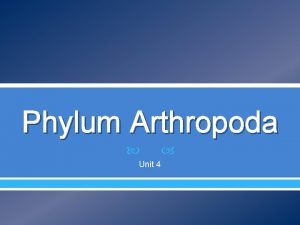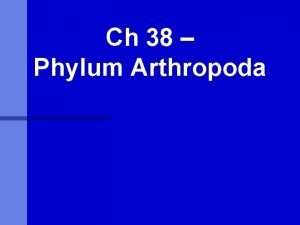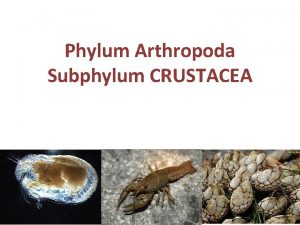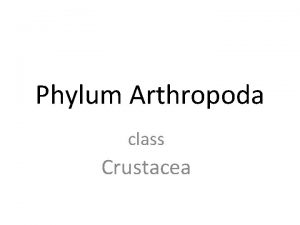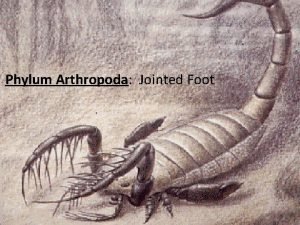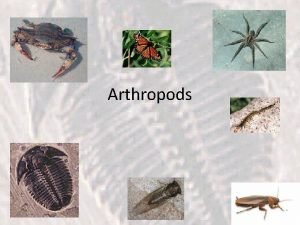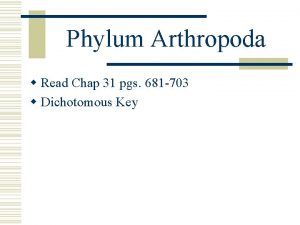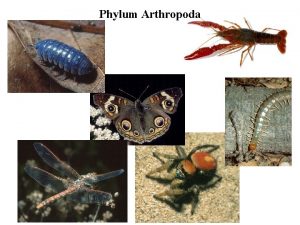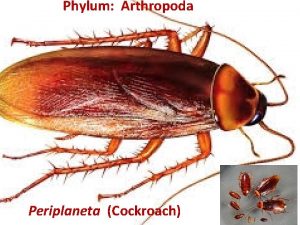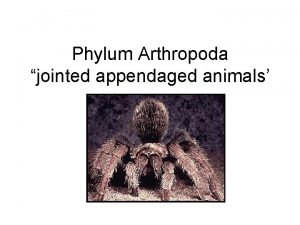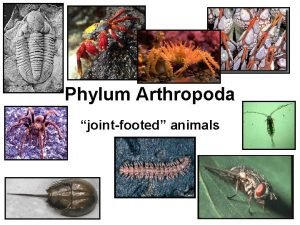Phylum Arthropoda Phylum Arthropoda Several million species Hard












- Slides: 12

Phylum Arthropoda

Phylum Arthropoda Several million species. Hard exoskeleton.

Phylum Arthropoda: Arthropods (crustaceans, spiders, insects) Hard exoskeleton, segmented bodies, jointed appendages Arthropods are the most successful of all animal phyla based on diversity, distribution, and numbers. Nearly one million species identified so far, mostly insects. The exoskeleton, or cuticle, is composed of protein and chitin. Open circulatory systems in which a heart pumps hemolymph through short arteries and into open spaces (sinuses). Aquatic members- gills for gas exchange; terrestrial members- tracheal system of branched tubes leading from surface throughout body.


Classes of Arthropods: A. Class Arachnida: 1. examples– spiders, scorpions, ticks, mites 2. main body parts – two – cephalothorax and abdomen 3. number of legs -four pair ( eight ) 4. mostly terrestrial

B. Class Insecta – the insects 1. examples – flies, ants, wasps, beetles, dragonflies, butterflies, cicadas mayflies, grasshoppers, crickets…. 2. main body parts – 3 – head, thorax and abdomen 3. number of legs – 3 pair (six) 4. mostly terrestrial

C. Class Chilopoda: 1. examples – centipedes 2. main body parts – many segments 3. number of legs – one pair (two) per segment 4. terrestrial 5. carnivorous 6. head has large antennae 7. first body segment modified as poison claws

D. Class Diplopoda 1. examples – millipedes 2. many body parts - many segments 3. number of legs – two pair ( four ) per segment 4. terrestrial, herbivorous

D. Class Crustacea 1. examples – crabs, lobsters, crayfish, shrimp, barnacles 2. body parts – two to three 3. number of legs – five pair ( ten ) usually 4. mostly marine

Class Crustacea E. g. , crabs, lobsters Almost all are aquatic. Ca. 40, 000 species. Includes krill eaten by whales, and daphnia, copepods, & amphipods in Lake Erie, pill bugs, etc.


 Phylum arthropoda
Phylum arthropoda Phylum arthropoda characteristics
Phylum arthropoda characteristics Phylum arthropoda
Phylum arthropoda Maxilla crayfish
Maxilla crayfish Phylum
Phylum Classes in phylum arthropoda
Classes in phylum arthropoda Kingdom animalia phylum arthropoda
Kingdom animalia phylum arthropoda Arthropods characteristics
Arthropods characteristics Reginald spider crab
Reginald spider crab One of the representatives of phylum arthropoda is
One of the representatives of phylum arthropoda is Phylum arthropoda common name
Phylum arthropoda common name Class insecta characteristics
Class insecta characteristics Classes in phylum arthropoda
Classes in phylum arthropoda
